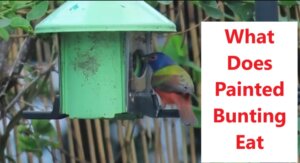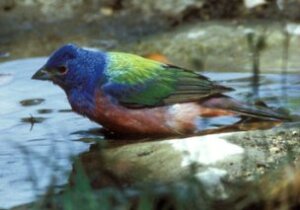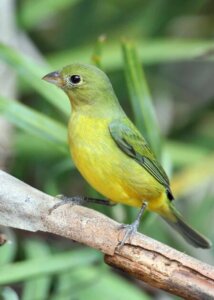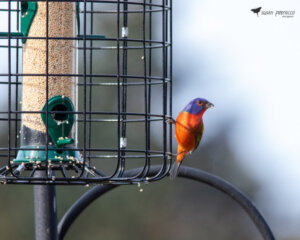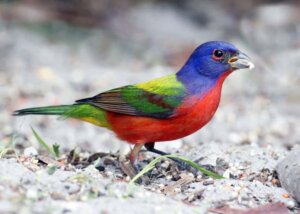How to Attract Painted Bunting to Feeder: Expert Tips
Want to attract the beautiful Painted Bunting to your feeder? These colorful birds are a joy to watch.
They add vibrant beauty to any garden. The Painted Bunting, known for its bright and vivid plumage, is a sought-after visitor for bird enthusiasts. Attracting these birds can be a delightful challenge. With the right approach, you can create an inviting space that draws them in.
Painted Buntings prefer specific types of food and habitat. To make your feeder irresistible, you need to understand their preferences. This guide will help you set up the perfect environment. From food choices to feeder placement, learn how to make your garden a haven for these stunning birds. Ready to bring a splash of color to your backyard? Let’s dive in.
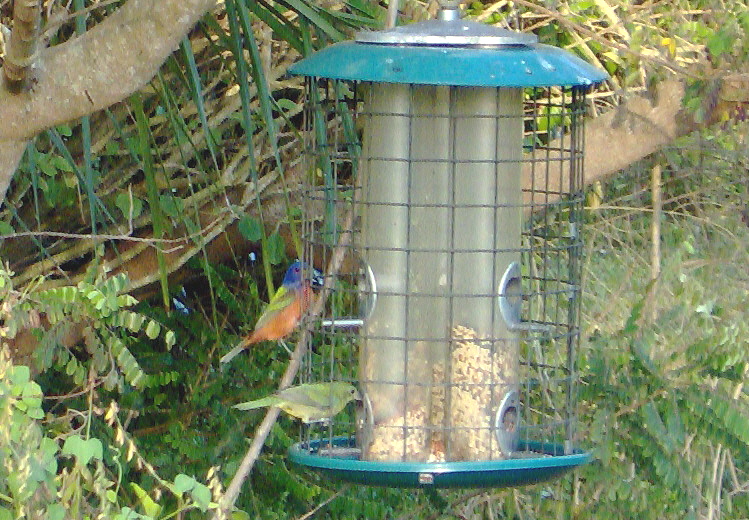
Credit: fairchildgarden.org
Choosing The Right Feeder
Choosing the right feeder is crucial to attracting Painted Buntings. These colorful birds are particular about their feeding environment. Selecting a suitable feeder can make your yard their favorite spot. Let’s explore the best types of feeders and where to place them.
Types Of Feeders
Painted Buntings prefer certain feeder types. Here are some of the best options:
- Tube Feeders: These feeders are perfect for small seeds. Painted Buntings love them.
- Hopper Feeders: These feeders store more food. They are great for attracting multiple birds.
- Tray Feeders: These feeders provide easy access. Birds can easily spot the food.
Feeder Placement
Where you place the feeder matters. Follow these tips for the best results:
- Height: Place feeders 5-7 feet off the ground. This keeps the birds safe from predators.
- Shade: Position feeders in shaded areas. This keeps the seeds fresh and cool.
- Visibility: Ensure the feeder is visible from a distance. Painted Buntings are attracted to open, visible spaces.
- Proximity to Water: Place feeders near a water source. Birds love having water nearby.
By choosing the right feeder and placing it correctly, you can attract Painted Buntings to your yard. Enjoy watching these beautiful birds!
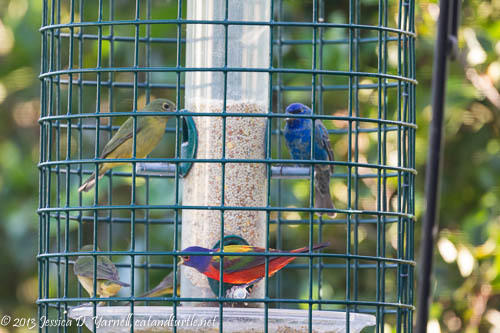
Credit: mtpleasant.wbu.com
Ideal Food For Painted Buntings
Attracting painted buntings to your feeder requires the right food. Knowing their dietary preferences is key. Painted buntings love seeds and enjoy some supplemental treats too. Let’s explore the ideal food to attract these vibrant birds to your garden.
Seed Preferences
Painted buntings have a particular taste for seeds. The following are their favorites:
- White Proso Millet: This seed is small and easy to eat.
- Black Oil Sunflower Seeds: These seeds are high in fat and energy.
- Safflower Seeds: A great option that also deters squirrels.
Consider offering these seeds in a mix. It will attract painted buntings more effectively. Place seeds in a hopper or platform feeder for easy access.
Supplemental Food
While seeds are the main diet, painted buntings enjoy some extras. Supplementing their diet can make your feeder more appealing.
| Food | Benefits |
|---|---|
| Mealworms | Rich in protein and easy to digest. |
| Fruits | Sweet treats like berries and oranges. |
| Suet | High in fat, great for energy. |
Offer these supplemental foods in small amounts. It adds variety to their diet. This approach keeps painted buntings coming back for more.
Creating A Bird-friendly Habitat
Creating a bird-friendly habitat is essential to attract painted buntings to your feeder. By providing the right environment, you can make your garden a haven for these beautiful birds. Focus on incorporating native plants and ensuring there are adequate water sources. These elements will make your garden more inviting and provide the resources that painted buntings need.
Native Plants
Native plants are crucial in creating a bird-friendly habitat. They provide food and shelter for painted buntings. Consider planting a variety of shrubs, trees, and flowers that produce seeds and berries. Some excellent choices include:
- American Beautyberry – Offers berries that buntings love.
- Black-eyed Susan – Attracts insects, which are a food source.
- Sunflowers – Provide seeds that many birds enjoy.
These plants not only offer nutrition but also create a natural environment that makes the birds feel at home. Avoid using pesticides, as they can harm both the plants and the birds.
Water Sources
Water is essential for birds. A reliable water source can attract painted buntings. Consider adding a birdbath or a small pond to your garden. Make sure the water is clean and fresh. Here are some tips:
- Shallow birdbath – Easy for small birds to access.
- Moving water – A fountain or dripper attracts birds.
- Regular cleaning – Prevents algae and keeps the water safe.
Painted buntings need water for drinking and bathing. By providing a clean and accessible water source, you can make your garden a more attractive destination for these colorful birds.
Seasonal Considerations
Attracting Painted Buntings to your feeder depends on the season. These colorful birds have different needs during their breeding and winter seasons. Understanding these needs helps you provide the right food and environment.
Breeding Season
The breeding season for Painted Buntings runs from late spring to summer. During this time, they need energy for nesting and feeding their young. Provide high-protein foods to meet these needs.
- Mealworms: These are a great protein source.
- Sunflower seeds: Offer black-oil sunflower seeds for their high-fat content.
- Nyjer seeds: Small seeds that are easy for buntings to eat.
Place feeders in quiet areas. Buntings prefer locations with dense shrubs and trees. They feel safer in such environments. Keep feeders clean to prevent disease. Fresh water is also essential. A birdbath nearby can attract more buntings.
Winter Feeding
In winter, Painted Buntings migrate to warmer regions. They are found in the southern United States and Central America. During this time, their dietary needs change slightly.
| Food | Reason |
|---|---|
| Millet | Easy to find and eat |
| Cracked corn | Provides needed carbohydrates |
| Safflower seeds | Rich in fat for energy |
Place feeders in sheltered areas. This protects the birds from harsh weather. Covering feeders with a roof helps keep food dry. Maintain a regular feeding schedule. Buntings will return if they know food is available.
Understanding these seasonal considerations ensures a welcoming environment for Painted Buntings year-round.
Dealing With Unwanted Pests
Dealing with unwanted pests is a crucial part of attracting Painted Buntings to your feeder. Pests like squirrels and insects can drive away these beautiful birds. Fortunately, there are effective ways to keep these pests at bay.
Squirrel-proofing
Squirrels are notorious for raiding bird feeders. They can quickly eat all the birdseed. To prevent this, use squirrel-proof feeders. These feeders have mechanisms that block access to squirrels. You can also place baffles on poles. Baffles are dome-shaped barriers that stop squirrels from climbing up. Another tip is to hang feeders away from trees. Squirrels can jump from nearby branches. Ensure there is at least 10 feet of clearance.
Insect Control
Insects can be a nuisance at bird feeders. They can spoil the food meant for birds. To keep insects away, clean feeders regularly. Use soapy water to wash away residues. Also, avoid using sugary foods. Sugar attracts ants and bees. Instead, opt for seeds that insects find less appealing. You can also use ant moats. These are small water-filled barriers. They prevent ants from reaching the feeder. For a natural insect deterrent, plant marigolds near the feeder. Marigolds repel many types of insects.

Credit: www.youtube.com
Monitoring And Maintenance
To attract Painted Buntings to your feeder, monitoring and maintenance are crucial. This ensures a clean and safe environment for these colorful birds. Let’s explore key steps to maintain and monitor your bird feeders effectively.
Cleaning Feeders
Clean your feeders at least once a week. This prevents mold and bacteria. Use warm, soapy water and a brush. Rinse thoroughly to remove soap residue. Allow the feeder to dry completely before refilling. A clean feeder attracts more birds and keeps them healthy.
Regular Observation
Observe your feeder daily. Check for signs of wear or damage. Ensure the feeder is not clogged. Watch for unwanted pests like ants or squirrels. Adjust your setup if needed. Regular observation helps you spot problems early and maintain a welcoming space for Painted Buntings.
Frequently Asked Questions
What Do Painted Buntings Eat?
Painted Buntings primarily eat seeds and insects. They love millet, sunflower seeds, and safflower. Offering these at your feeder will attract them.
When Is The Best Time To Attract Painted Buntings?
The best time is during their breeding season, from May to August. This is when they are most active and visible.
Where Should I Place The Feeder?
Place the feeder in a quiet, sheltered area. It should be near shrubs or trees for safety and cover.
What Type Of Feeder Attracts Painted Buntings?
Tube feeders with small perches are ideal. They also like platform feeders. Ensure it’s squirrel-proof to protect seeds.
Conclusion
Attracting Painted Buntings can be a rewarding experience. Offer fresh seeds and clean water. Position feeders in a quiet, safe spot. Use native plants to create a welcoming habitat. Patience is key. Keep the feeders clean and well-stocked. Soon, these colorful birds will visit your garden.
Enjoy the beauty and joy they bring. Happy bird watching!
Hello Dear, I'm Poli Kolymnia, owner of many birds (including budgies).
With a deep passion for these feathered companions, I'm here to share my expertise and extensive knowledge on birds care.
My articles cover essential topics like diet, housing, care, and health, providing practical tips to help you create a happy and thriving environment for your birds.


